Best Greek Restaurant
Mandolin Aegean Bistro
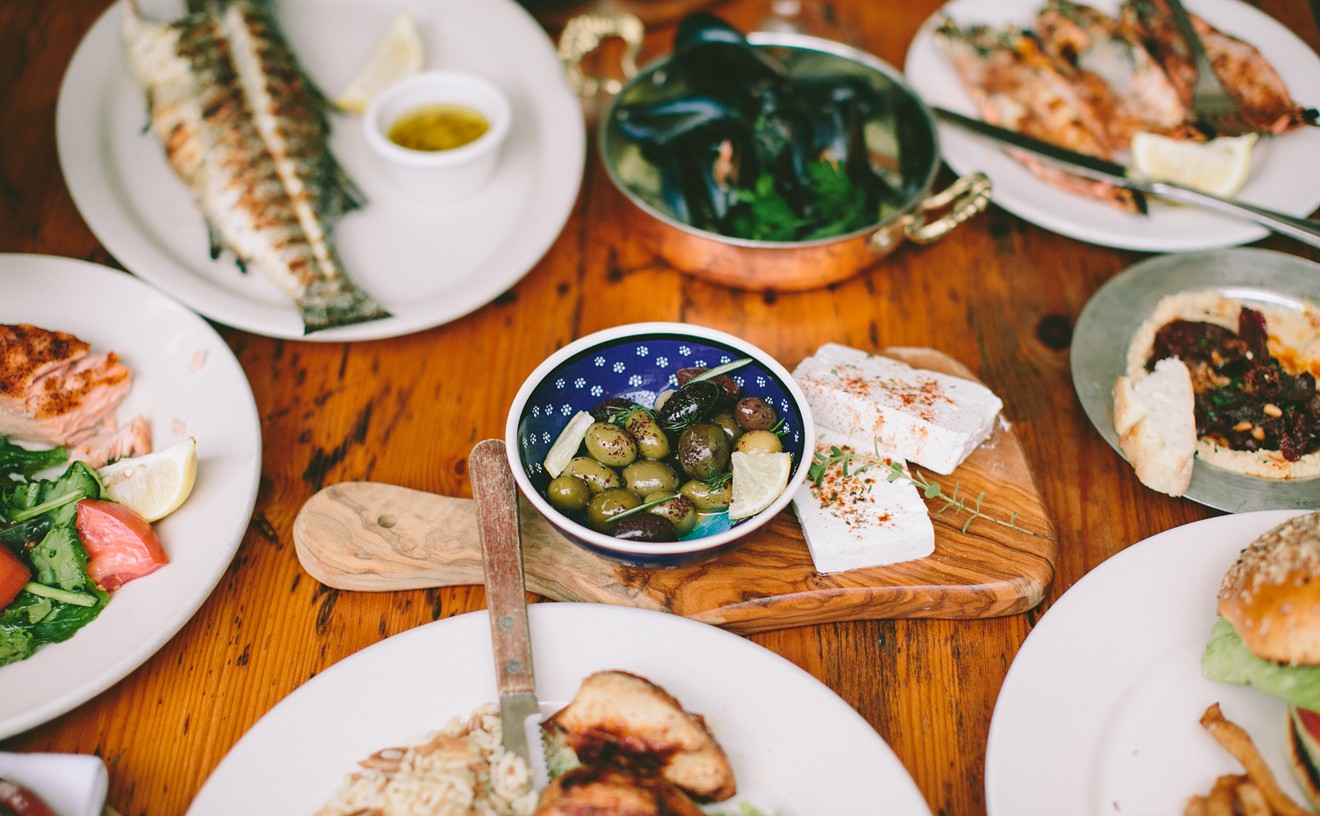
Match the letter with its proper corresponding number and win a better grasp of the great Greek bistro that opened in Miami's Buena Vista neighborhood this past year:A. What diners are brought before dinner.B. Steamed mussels, fried calamari, flamed cheese saganaki, kefte meatballs, tzatziki, tarama.C. A difference between Mandolin and other Greek joints.D. The dining room.E. Key West Sunset Ale.F. Hand-cut French fries, grilled octopus, classic Greek salad.G. Forty seats, lanterns dangling from leafy trees, the tweets of little birds filling the balmy night air.H. Thinly shredded romaine leaves, feta crumbs, scallions, and fresh dill tossed in light vinaigrette.I. $15 to $19.1. Two of the owners are from Turkey (the other is Greek), so the menu includes Turkish delights such as fava bean purée, tomato-walnut dip, and sucuk (known as Turkish chorizo).2. About 17 seats snuggled together in what might have been used as a walk-in closet in the original 1940s house.3. Maroulosalata.4. One of the beers offered along with well-priced wine.5. Cost of entrées, including a pristinely grilled whole yellowtail with lemon and olive oil.6. Warm, sesame-dotted loaves of pide bread in a paper bag.7. Some of the dozen-plus mezes ($7 to $12).8. Mandolin's outdoor patio, open for lunch and dinner every day.9. Three of our favorites.
- 4312 NE Second Ave., Miami, 33137 Map
- 305-749-9140
- www.mandolinrestaurant.com
Best Japanese Restaurant
Naoe
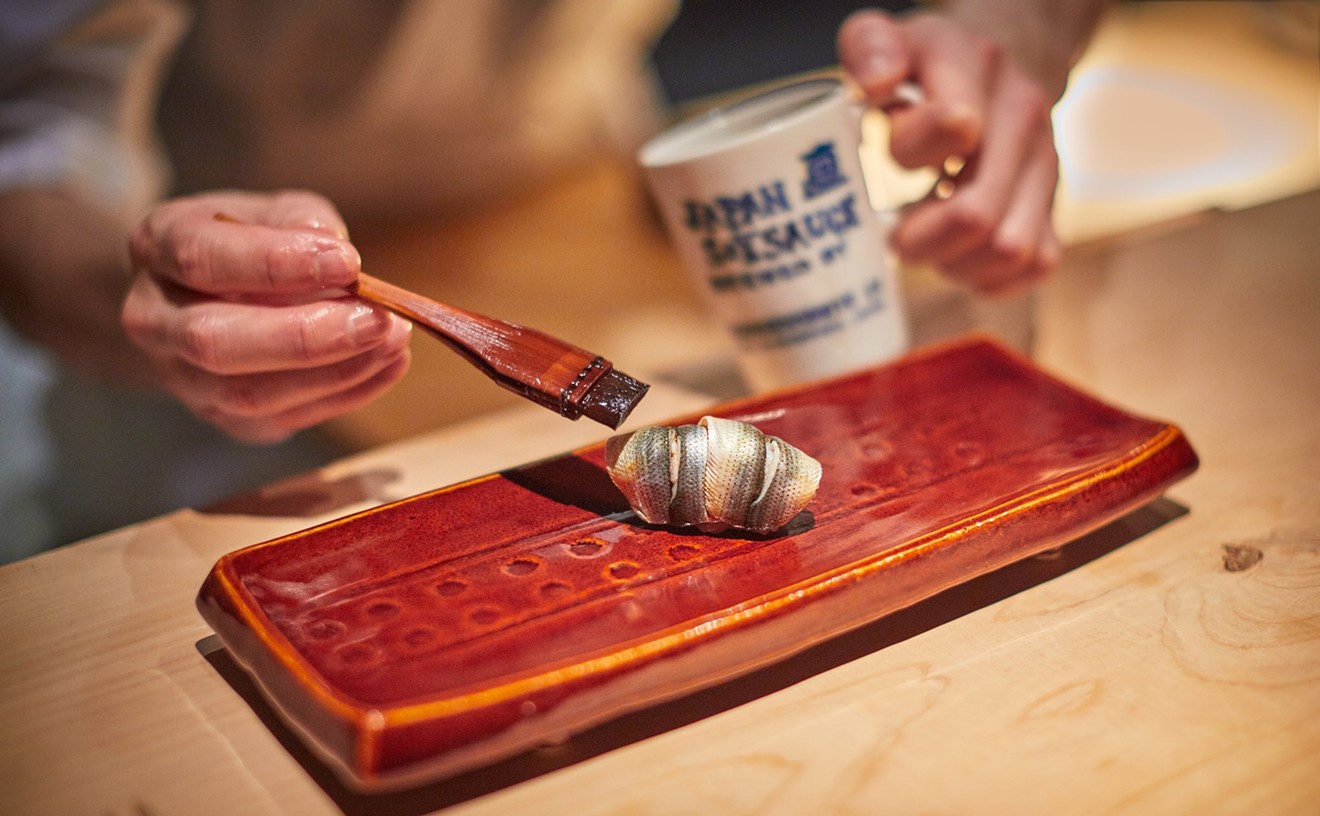
Photo by Jeff Salter
Top 10 differences between Naoe and your favorite Japanese restaurant — or, for that matter, any restaurant: 1. Chef/owner Kevin Cory worked in Japan at a traditional kaiseki restaurant, put in a startlingly impressive stint locally at Siam River, and has relatives that own sake and shoyu breweries in Oono and Ishikawa. 2. Live scallops, mirugai, aoyagi, anago, unagi, hamachi, oysters, baigai, tokobushi, and asari.3. Frozen Kaga No Yukizake sake.4. Menu consists of four-item chef's choice (omakase) bento box plus a bowl of soup on the side. Afterward, the chef prepares nigiri sushi if you're still hungry.5. Silver-skinned aji glazed with shoyu and plated with pickled wasabi leaves and flowers. 6. Just 17 seats and a five-seat sushi bar — less a restaurant than a dinner party.7. Salmon wrapped in pickled white seaweed with roasted freshwater eel and fried shrimp tamago — like everything else, personally conceptualized and prepared to order by Chef Cory.8. Open Wednesday through Sunday, with three seatings (8 p.m., 9, and midnight); reservations necessary and only through OpenTable.com. 9. Rice molded with shiitake mushrooms and hints of eel, with wisps of pickled daikon on top.10. Price for dinner (bento box and soup): $26.
- 661 Brickell Key Dr., Miami, 33131 Map
- 305-947-6263
- naoemiami.com
Best Thai Restaurant
Sea Siam
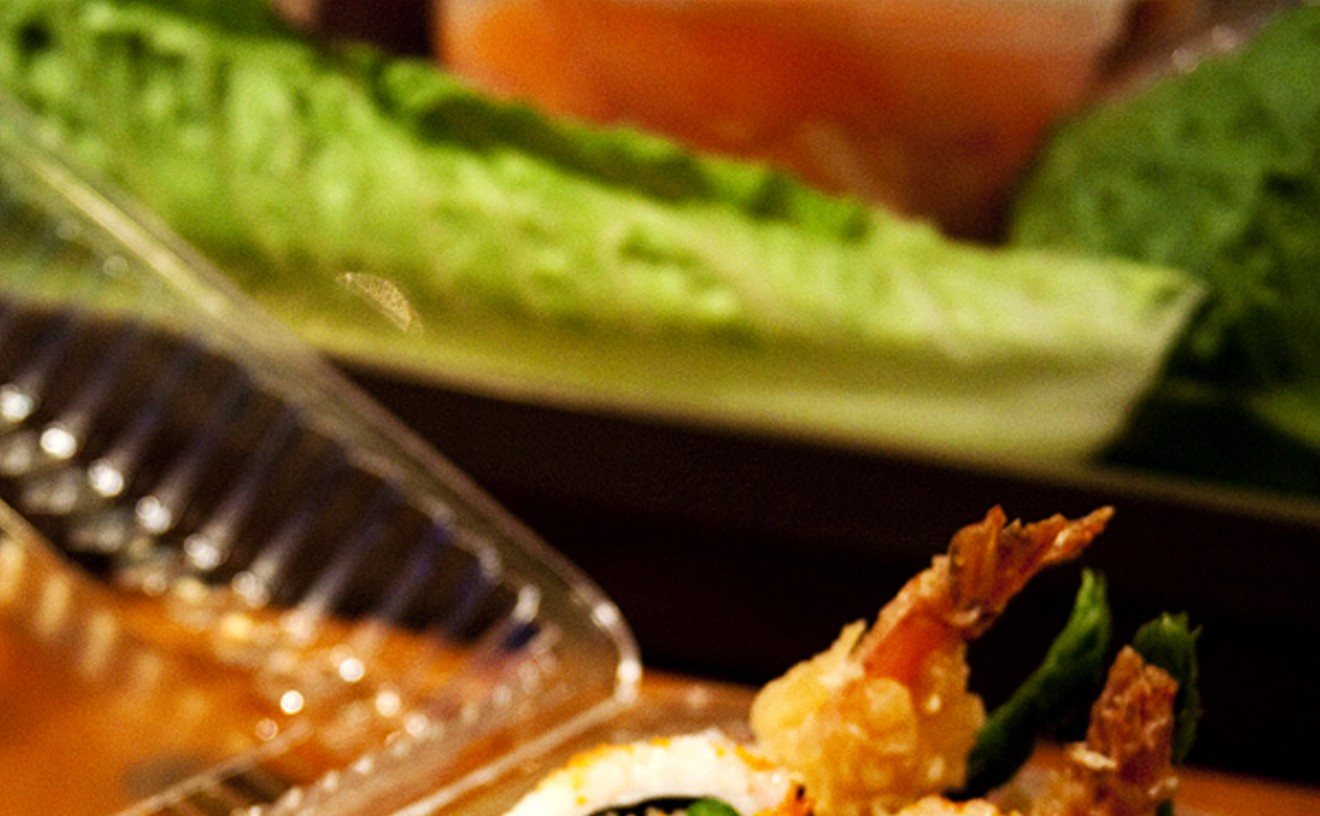
Natalia Molina
It's usually a good rule of thumb that you shouldn't ingest any food included in a restaurant's name. If you did, can you imagine how many canton-bamboo-lotus-crane-stars you would have consumed? Think about the heartburn! Yet Sea Siam's case is different. The fare is pretty oceanorific. Take the pla lad prig: a fresh, whole fried snapper with delicate, crisp skin and moist white meat drenched in a spectacularly tangy, sweet, and spicy chili sauce for $22 (also comes filleted for $19). Then there's the fabulous crispy duck, ped nam dang, which comes with cashews, sweet peas, black mushrooms, baby corn, pineapple, and a rich sauce that can be spiked to any degree of heat ($18.50). Or check out these sea-crumptious sushi rolls: the shrimp tempura and cream cheese delight, called the "red rose roll" ($13); and the "kissing roll" ($10), a California roll topped with smoked salmon and eel sauce. Still not convinced? The tom kar gai (chicken coconut soup, $6) is tasty enough to make a fowl wish it had flippers.
- 12735 S. Dixie Highway, Pinecrest, 33156 Map
- 305-233-5599
- www.seasiam.com
Best French Bistro
Petit Rouge

Aran S Graham
Neal Cooper doesn't look, act, or speak like a Frenchman. Fair enough: He isn't French. His prior restaurant, Il Migliatore, and his eponymous eatery from 1993 were both excellent; neither, however, was French. Mr. Cooper did dabble in Escoffier and the French classics at the Culinary Institute of America, but more important, he knows how to operate a restaurant that regardless of ethnicity, delivers what people want: Delicious food and wine at a good value served efficiently in a pleasing environment. At Petit Rouge, this translates into a charmingly rustic 24-seat bistro and petite eight-seat patio; into some 70 wines starting at $28 a bottle and by-the-glass choices from $8 to $14; into crunchy baguettes, textbook French onion soup, salmon tartare, ris de veau in lemon-caper sauce, rashers of calf's liver with bronzed onions on top, truite grenobloise, and frisée salad with lardons of bacon and an impeccably poached egg. Entrées run $20 to $24, making the homemade tarte tatin or impossibly smooth pot de crème that much harder to resist. Chef Cooper may not be fluent in French, but Petit Rouge speaks the language like no other place in town.
- 12409 Biscayne Blvd., North Miami, 33181 Map
- 305-892-7676
Best Haitian Restaurant
USA Seafood and Car Wash

Step out of Miami and into Port-au-Prince at USA Seafood and Car Wash, a character-driven Little Haiti joint notable for its giant parking lot. This place is popular for its take-out, so don't let the Styrofoam containers and plasticware put you off. Try the griot. The fried pork chunks are plentiful, have a nice fat-to-meat ratio, and are spiced for a kick. We recommend the side of white rice, bean sauce, and crisp, greaseless fried plantains; it all adds up to a mountain of food that serves two or three at an absurdly economical price of about $6. Other fine options include the tender-boned chicken in sauce, with goat, oxtail, or legume. Make sure to ask for some pikliz, a traditional spicy vinegar coleslaw; grab a cavity-sweet banana soda; and take your to-go order off to the far wall by the car wash. Sit at the concrete table, relax, and enjoy the sights and sounds of one of Miami's most vibrant neighborhoods.
- 6010 NE 2nd Ave., Miami, 33137 Map
- 305-756-6555
Best Indian Restaurant
Imlee Indian Bistro
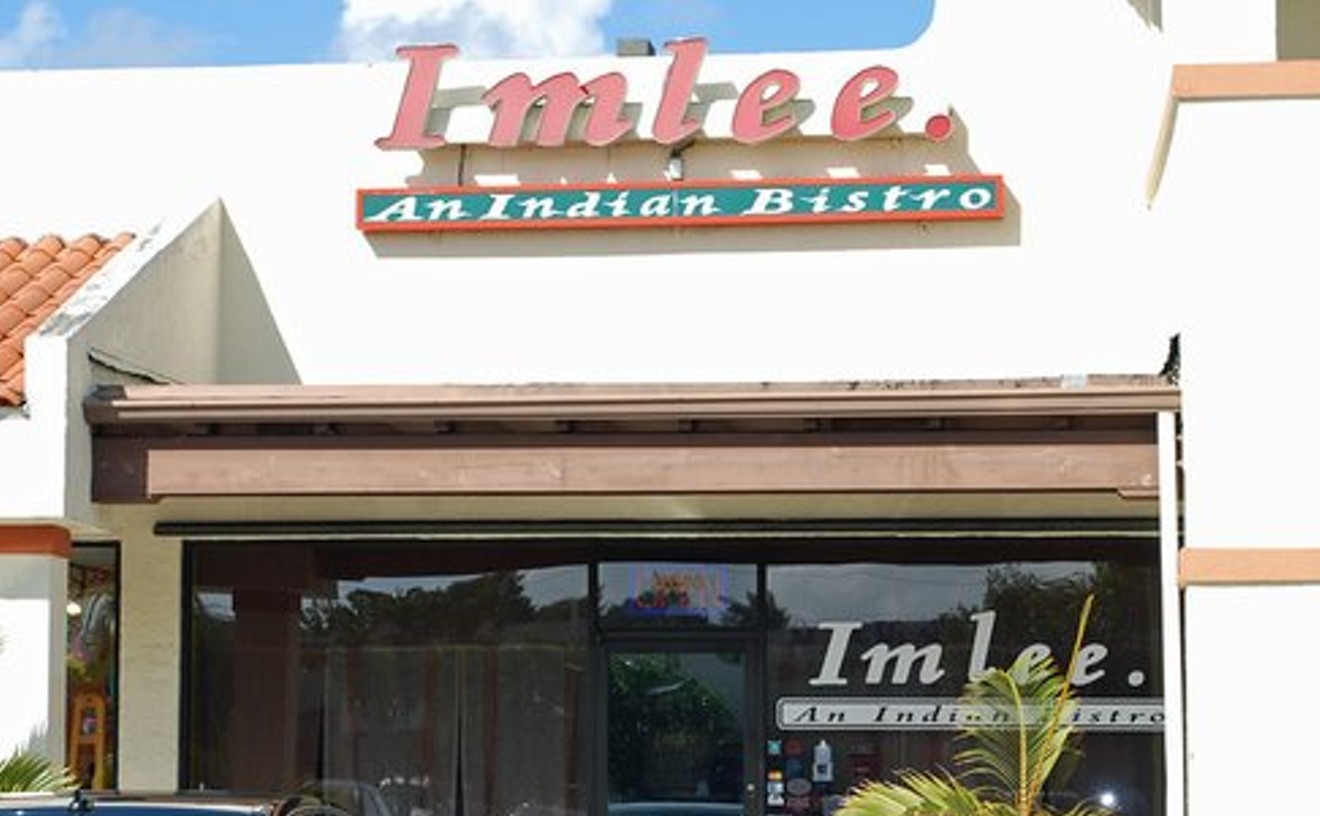
Steve++Satterwhite
A+tiny+space%2C+but+enough+room+for+a+chutney+chowdown
You have to look pretty darn hard to find chow from the place where Columbus thought he had arrived. Sure, there are plenty of the walk-up cafeterias selling café cubano. And you can find yuca fries. But you could drive for miles and never find any chai lassi, raita, or garlic nan. Luckily, there's a small Indian restaurant called Imlee in a nowheresville strip mall in Pinecrest with some pretty damn good korma, vindaloo, and koftka curry. We usually start with paneer porka: wonderfully soft cheese that's been battered, fried, and then steeped in spicy, tomatoey goodness. Depending on our mood, we vacillate between the creamy mixed vegetable korma and the tasty lamb koftka curry. And we always get a side of raita and an order or two of pillowy nan. A frosty Kingfisher brew is required to wash it all down, and if there's room, we try the falooda ice cream. Made from rose syrup, it's what luxury would taste like if you could put it on a spoon.
- 12663 S. Dixie Highway, Pinecrest, 33156 Map
- 786-293-2223
- www.imleeindianbistro.com
Best Cuban Restaurant
Las Culebrinas

Eat at a Cuban restaurant and expect big portions. It's never just a palomilla steak; it's always some kind of gazelle on a plate. In this respect, Las Culebrinas doesn't disappoint. You'll get enough to satisfy a recently arrived, starved balsero. But it's in the execution where you'll get your money's worth here. Cuban food is typically pedestrian; there's only so much you can do with beans and rice. Maybe add some capers to the beans, or get adventuresome with the seasoning; it'll taste good no matter your skill level in the kitchen. But this locally owned mesón — which has locations on SW 27th Avenue, on West Flagler, in Pinecrest, and in Hialeah — serves a staple like vaca frita ($12.95) over a bed of fufu, AKA mashed plantains. Or try something sticky such as pork chunks ($12.95) on a cool bed of avocado sauce. It's a mix of flavors that shouldn't work yet feels as homey as Cuban Spanglish. Las Culebrinas also serves tapas. These aren't bite-size meals, though. Tread carefully if you're a light eater, because these aren't your abuelita's tapas. Las Culebrinas is for all those times when you've finished your saucer of fried garbanzos (here sautéed over sliced ham) ($7.50) or that queso Manchego (in robust portions here) ($7.95). Leave it to Cubans to do justice to a Spanish tradition.
- 4700 W. Flagler St., Coral Gables, 33134 Map
- 305-445-2337
- www.culebrinas.com
Best Croquetas
Versailles
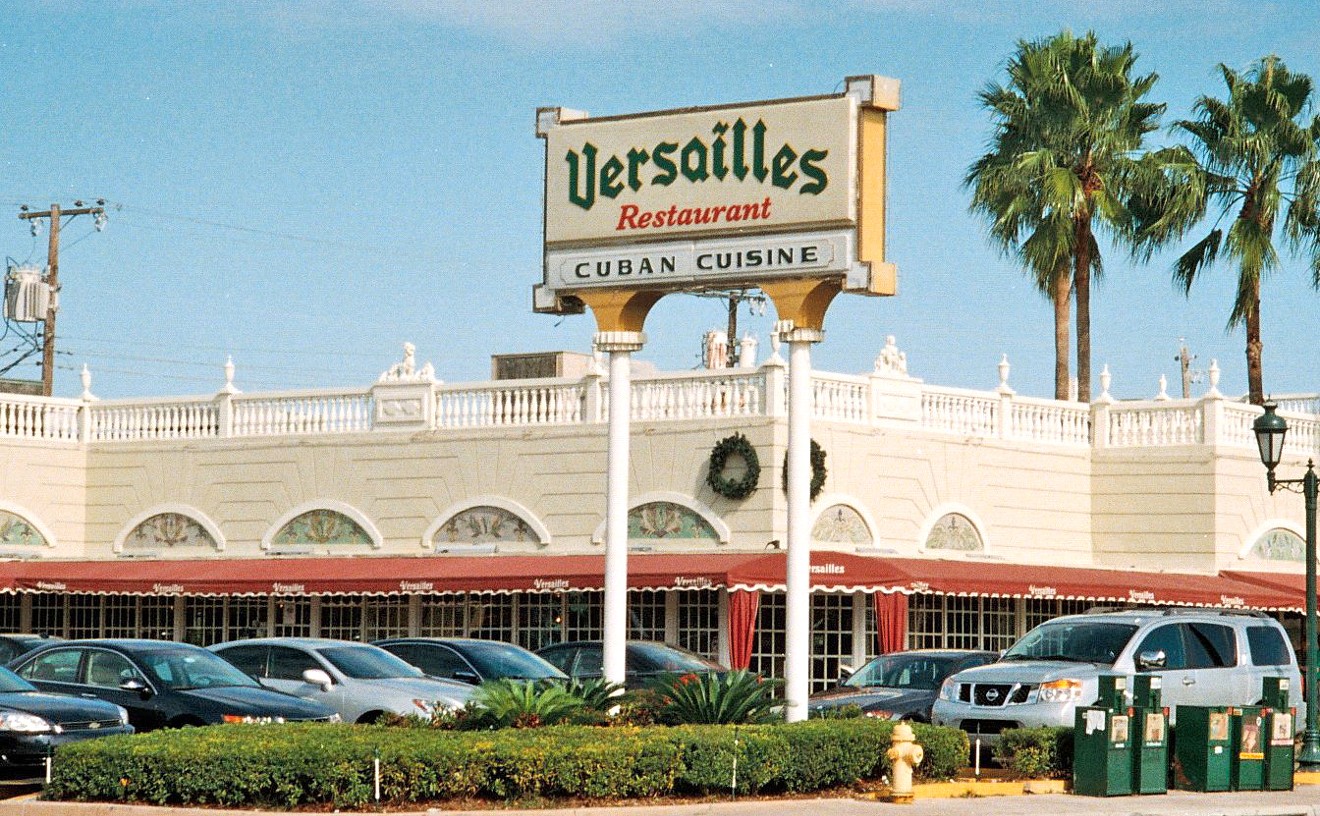
Photo by Phillip Pessar via Flickr Creative Commons
Cuban or not, if you live in Miami, you have tasted croquetas — those delicious, deep-fried nuggets of meat and béchamel. You know, the ones neatly piled next to the pastelitos de guava at every bakery, gas station, and birthday party. The real quest is to find the diamonds in the Cuban-pastry rough. So it seems only logical for the standout croqueta de jamón to be found at the mecca of Miami's Cuban community: Versailles. The treats are offered inside and at the adjacent bakery, but hit up the outside restaurant window for the authentic experience. Lean in, ask for dos croquetas de jamón con limón, pay the $1.70, and crack some jokes — chistes — with the window's regulars. Open since 1971, Versailles has done much more than serve as the Cuban-American epicenter for protests and celebrations; the Calle Ocho staple has pumped out hundreds of Miami's finest 85-cent fried-meat cylinders daily. Chicken and codfish options are also available. Versailles is open 8 a.m. to midnight Monday through Saturday and 8 a.m. to 9 p.m. Sunday. For the full effect, take one croqueta, squirt with desired amount of lime, place between two crackers, and squish. Stay awhile — salsa music seems to help the croqueta digestive process.
- 3555 SW Eighth St., Miami, 33135 Map
- 305-444-0240
- www.versaillesrestaurant.com
Best Cuban Sandwich
El Rey de las Fritas

Bueno. Bonito. Barato. Those who don't speak Spanish, feel free to Google. The three-word alliteration loosely means "pretty darn tasty and cheap." Any way you put it, when it comes to the best sandwich in the Magic City, nothing comes close to a frita. And who else would make the best but the king? El Rey de las Fritas makes just about the best frita this side of Havana. You might have been thinking that ham concoction called a "Cuban sandwich" when you began reading this item, but we have a surprise for you. The Cuban hamburger here is a spiced, chorizo-infused patty served on a warm Cuban-bread bun with diced onions and piled high with crunchy, golden shoestring potatoes. The meat is tender and juicy, the fries are hot and crisp, and the secret sauce (good luck finding out the ingredients) makes you want to lick your lips, fingers, and anywhere else it might fall. Some tourists mix with the mostly local crowd sitting around a long counter and surrounding booths, having a boisterous, or Cuban, chat over a delicious feast. The cafecito, of course, is a typical after-frita reward. The menu is gringo-friendly, displaying all selections in both Spanish and English with pictures, and almost everything costs less than $4 (a frita goes for $3.25). Open Monday through Saturday 8 a.m. to 10:30 p.m., and with a handful of locations from Doral to Hialeah, plus the flagship on Calle Ocho in Little Havana, there is no excuse not to stop in to try a frita.
- 9343 Bird Rd., Miami, 33165 Map
- 305-223-9944
Best Foodie Frankenstein
El Rey del Chivito

If Dr. Victor Frankenstein had been born an unnaturally hungry Uruguayan food fanatic and not an Austrian alchemist hell-bent on cobbling together a humanoid creep show from dead body parts, he might have invented El Rey del Chivito's trademark creation, the Chivito Rey Emperador. Basically a monstrous mountain of random foodstuffs, the Rey looks like it was dredged from the kitchen's scrap bin: creamy potato and peas, garden salad, shoestring French fries, blobs of mozzarella cheese, 16 ounces of churrasco beef, bacon strips, ham chunks, and a pair of sunny-side up eggs. To a certain extent, this peculiar platter is a dementedly deconstructed version of the OG chivito steak sandwich minus the soft roll. In another way, however, it's the wildly outsize offspring of a crazy culinary mind, namely resident Doc Frankenstein and owner Aron Wolfson. Submit to this strangely delicious $18.90 family-style serving. The Rey will feed your entire brood — mom, dad, kiddies, grandma, and nanny, plus dog. But be careful or it just might come alive and consume you.
- 6987 Collins Ave., Miami Beach, 33141 Map
- 305-864-5566
- www.elreydelchivito.com





